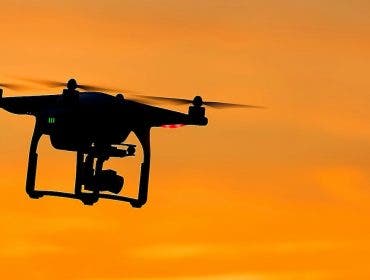Drone technology has advanced rapidly during the last decade. Since the launch of the original DJI Phantom in 2013, drones have evolved from being simple recreational aircraft, to becoming advanced scientific tools that are essential cornerstones of higher education.
The emergence of drone technology is transforming the educational landscape for educators and students alike. Drones provide access to important academic data that wasn’t easily attainable in the past. They also create new pathways for higher educational institutions to gain funding for scientific research, and attract students who are looking for careers in an emerging field that offers exciting opportunities.
Early Drone Education Pioneers
Several notable universities have been early pioneers in the implementation of drones and drone-related technologies:
- Texas A&M conducts research in remote sensing drone technologies for data-informed decision-making in farming and agriculture.
- The University of Alaska at Fairbanks uses drones to support pathfinder missions within the Arctic and sub-Arctic regions.
- Virginia Tech develops autonomous drone systems for surface, and sub-surface research applications.
The development of drone programs by these pioneering schools helps to advance the proliferation of drone technology in higher education. It also empowers other colleges and universities to integrate drone technologies into their own higher education programs.
Schools are incorporating drones into a range of academic fields, including:
- Ecosystem sciences
- Agricultural engineering
- Animal sciences
- Geography
- Archeology
- Aviation
- Mechanical engineering
- Robotics
- Journalism
- Art

Drones at The University of Washington
The University of Washington’s Department of Aeronautics and Astronautics – Autonomous Flight Systems Lab (AFSL) has recently been deploying drones to study glacial snow pack levels, and to conduct research for public-safety search and rescue operations. The UW AFSL allows students to work closely with industry partners on research for autonomous drone operations. It applies advanced avionics, sensors, and other payloads to various aerial platforms. This includes off-the-shelf fixed wing, and multi-rotor uncrewed aerial systems. AFSL offers courses in flight mechanics and controls, which support advances in (GNC); guidance, navigation, and control technology, relevant to autonomous vehicles and their payloads.
You can also read How Are Public Safety Agencies Funding Their Drone Programs?
Students of the UW AFSL are also using drones to work on scientific research projects that were typically more challenging. Drones are making previously hazardous terrain more accessible. They are also making it easier to carry the needed instrument payloads that used to be difficult to deploy.
AFSL drones are being adapted to carry ground penetrating radars (GPR). These study the changes in the snowpack levels of glaciers. AFSL GPR-enabled drones help to reduce the risks associated with gathering data in hazardous environments. This is because they can gather valuable data remotely and avoid putting scientists and equipment at risk.
Another important example of how drones are being used at UW is the machine-learning dataset that the AFSL is building. Its a computer-vision AI model. This is intended for use in the rapid location of individuals who may get lost in the wilderness. The program uses drone imagery to build an AI model for human-object recognition. This aims to be more accurate at detecting recognizable human objects than public safety officials who would be looking at drone footage with their own eyes.
In addition to providing drone-related higher education opportunities, this program illustrates how drones have ancillary benefits to the community. It can decrease the overall cost of search-and-rescue missions for local public safety operations. It can also reduce the budgetary strain on local law enforcement departments. Most importantly, it can help to quickly find lost individuals through the use of computer vision and machine learning.
Drones at The University of Vermont
The Spatial Analysis Laboratory (SAL) at The University of Vermont is a cutting-edge Geographic Information System (GIS) research facility in the Rubenstein School of Environment & Natural Resources. It specializes in ecosystem assessments, biodiversity analysis, land-cover mappings, conserved lands planning, scenario modeling, LiDAR processing, web-based mapping, and transportation analysis.
As a pioneer in the use of drones for GIS research projects, SAL is renowned for its expertise in disaster response, agricultural assessment, archeological site mapping, aquatic resource mapping, transportation decision support, and urban planning. SAL has used drones to conduct more than 75 tree-canopy assessments in the United States and Canada. It has captured high-resolution land-cover mapping imagery at state and regional levels, automated mapping of wetlands and other ecological features, and in other drone missions for flooding events.

Obtaining FAA’S UAS Collegiate Training Initiative Program Designation – (UAS-CTI)
Demand for qualified professionals in the Uncrewed Aircraft Systems industry is higher than ever before. In response to the ever-increasing demand — and in order to ensure that emerging technologies are being safely integrated into National Airspace System — the FAA has established its UAS Collegiate Training Initiative (CTI). This program is designed to prepare students for careers in the UAS industry.
Here’s Where to Learn about UAS Training for Public Safety
Colleges and universities that offer UAS curriculums can apply to receive recognition as a UAS-CTI school from the FAA. Receiving a distinction as an FAA UAS-CTI school can be beneficial for higher educational institutions and students alike. UAS-CTI designated schools become members of the Consortium for Small Uncrewed Aircraft System Technology Training, and have an opportunity to shape the future of UAS technologies and innovations. Students who are looking to start a career in the UAS industry will benefit from the innovative education that they will receive from schools who have been designated as Centers for Excellence in UAS technology training by the FAA.
Difference Between a UAS Degree and a Certification
Embry-Riddle Aeronautical University is an FAA UAS-CTI certified school which offers both a Bachelor of Science degree in Uncrewed Aircraft Systems, and a certificate program in sUAS operations and safety.
The Bachelor of Science degree in Uncrewed Aircraft Systems covers the full spectrum of educational topics for both commercial and civil UAS operations. In order to obtain the degree, students must complete a total of 120 credits. This includes a hands-on capstone project with local commercial UAS partners. Additionally, graduates will train at the school’s on-campus airfield with various fixed wing and rotary UAS aircraft. They will earn their FAA Part 107 Remote Pilot In-Command (RPIC) certificate as part of the degree program.
In contrast to the broad spectrum of education offered by the UAS Bachelor of Science degree, Embry-Riddle also offers a certificate program in sUAS operations and safety. The program covers four courses including: Introduction to Aeronautical Science, Introduction to Aerospace Safety, sUAS Flight and Mission Planning, and Uncrewed Aerial Vehicles and Systems.

Drone Careers
Graduates with degrees and certificates in UAS are helping to evolve a number of different civil and commercial industries.
They are helping to make inspections more efficient in the oil and gas industries, the construction industries, and in agriculture. The creative industries are able to benefit from UAS graduates who are experts in aerial cinematography, which previously required the use of helicopters and expensive stabilized cameras.
Public safety like the police, search-and-rescue, and fire departments are all in need of skilled UAS graduates to operate and develop hardware and software that can save lives, rescue lost individuals, and predict the path of forest fires in real-time.
Journalism is another industry that is increasingly in need of skilled UAS operators. Having the ability to tell a story from the vantage point that can only be obtained through the use of UAS aircraft is highly desirable for media outlets, making skilled UAS graduates a highly demanded group of individuals.
Companies like Google, Amazon, and UPS are all actively developing their UAS delivery programs. This offers compelling career opportunities for UAS graduates and certificate holders who are looking for a career in a sector that will change the way we ship and receive goods.
These are all examples of current career opportunities for UAS graduates and certificate holders. The field is just beginning to grow, with limitless potential for those who want to pursue a career in the UAS industry.
Why Having a UAS Program in Higher Education is Essential
There’s no question that UAS technology is an essential cornerstone of scientific research and higher education in today’s society. Schools and universities should highly consider developing a certified UAS program that meets the needs of both students and faculty.
Offering a robust UAS curriculum is essential for schools and universities who don’t want to miss out on attracting students who are looking for UAS-related careers.
With the wide range of benefits that are enabled through UAS related education and technologies, schools can no longer afford not to offer higher education options in a field that is quickly becoming highly sought after by students and employers.
You can download this information by filling out the form below:






